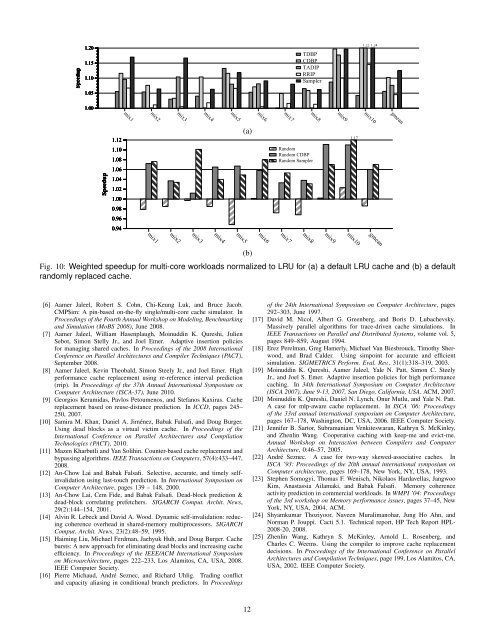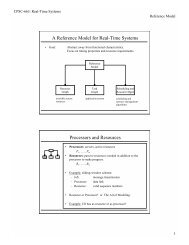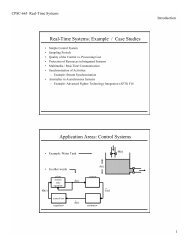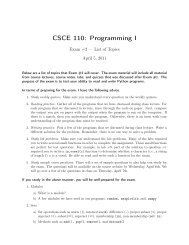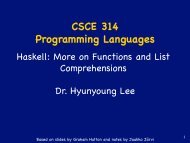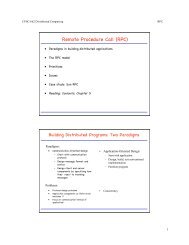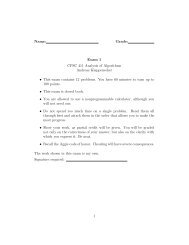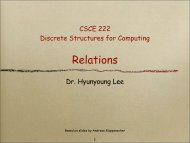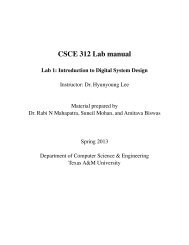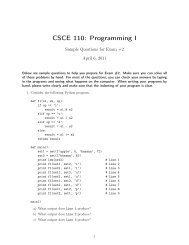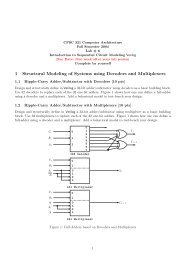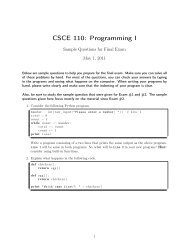Sampling Dead Block Prediction for Last-Level Caches - TAMU ...
Sampling Dead Block Prediction for Last-Level Caches - TAMU ...
Sampling Dead Block Prediction for Last-Level Caches - TAMU ...
You also want an ePaper? Increase the reach of your titles
YUMPU automatically turns print PDFs into web optimized ePapers that Google loves.
mix2mix3mix4mix5mix6mix7mix9Speedup1.201.151.10TDBPCDBPTADIPRRIPSampler1.22 1.241.051.00mix8mix10gmean1.12mix1(a)1.101.081.06RandomRandom CDBPRandom SamplerSpeedup1.041.021.000.980.960.94mix71.17mix2mix1mix4mix3mix5mix6mix9mix8gmeanmix10(b)Fig. 10: Weighted speedup <strong>for</strong> multi-core workloads normalized to LRU <strong>for</strong> (a) a default LRU cache and (b) a defaultrandomly replaced cache.[6] Aamer Jaleel, Robert S. Cohn, Chi-Keung Luk, and Bruce Jacob.CMP$im: A pin-based on-the-fly single/multi-core cache simulator. InProceedings of the Fourth Annual Workshop on Modeling, Benchmarkingand Simulation (MoBS 2008), June 2008.[7] Aamer Jaleel, William Hasenplaugh, Moinuddin K. Qureshi, JulienSebot, Simon Stelly Jr., and Joel Emer. Adaptive insertion policies<strong>for</strong> managing shared caches. In Proceedings of the 2008 InternationalConference on Parallel Architectures and Compiler Techniques (PACT),September 2008.[8] Aamer Jaleel, Kevin Theobald, Simon Steely Jr., and Joel Emer. Highper<strong>for</strong>mance cache replacement using re-reference interval prediction(rrip). In Proceedings of the 37th Annual International Symposium onComputer Architecture (ISCA-37), June 2010.[9] Georgios Keramidas, Pavlos Petoumenos, and Stefanos Kaxiras. Cachereplacement based on reuse-distance prediction. In ICCD, pages 245–250, 2007.[10] Samira M. Khan, Daniel A. Jiménez, Babak Falsafi, and Doug Burger.Using dead blocks as a virtual victim cache. In Proceedings of theInternational Conference on Parallel Architectures and CompilationTechnologies (PACT), 2010.[11] Mazen Kharbutli and Yan Solihin. Counter-based cache replacement andbypassing algorithms. IEEE Transactions on Computers, 57(4):433–447,2008.[12] An-Chow Lai and Babak Falsafi. Selective, accurate, and timely selfinvalidationusing last-touch prediction. In International Symposium onComputer Architecture, pages 139 – 148, 2000.[13] An-Chow Lai, Cem Fide, and Babak Falsafi. <strong>Dead</strong>-block prediction &dead-block correlating prefetchers. SIGARCH Comput. Archit. News,29(2):144–154, 2001.[14] Alvin R. Lebeck and David A. Wood. Dynamic self-invalidation: reducingcoherence overhead in shared-memory multiprocessors. SIGARCHComput. Archit. News, 23(2):48–59, 1995.[15] Haiming Liu, Michael Ferdman, Jaehyuk Huh, and Doug Burger. Cachebursts: A new approach <strong>for</strong> eliminating dead blocks and increasing cacheefficiency. In Proceedings of the IEEE/ACM International Symposiumon Microarchitecture, pages 222–233, Los Alamitos, CA, USA, 2008.IEEE Computer Society.[16] Pierre Michaud, André Seznec, and Richard Uhlig. Trading conflictand capacity aliasing in conditional branch predictors. In Proceedingsof the 24th International Symposium on Computer Architecture, pages292–303, June 1997.[17] David M. Nicol, Albert G. Greenberg, and Boris D. Lubachevsky.Massively parallel algorithms <strong>for</strong> trace-driven cache simulations. InIEEE Transactions on Parallel and Distributed Systems, volume vol. 5,pages 849–859, August 1994.[18] Erez Perelman, Greg Hamerly, Michael Van Biesbrouck, Timothy Sherwood,and Brad Calder. Using simpoint <strong>for</strong> accurate and efficientsimulation. SIGMETRICS Per<strong>for</strong>m. Eval. Rev., 31(1):318–319, 2003.[19] Moinuddin K. Qureshi, Aamer Jaleel, Yale N. Patt, Simon C. SteelyJr., and Joel S. Emer. Adaptive insertion policies <strong>for</strong> high per<strong>for</strong>mancecaching. In 34th International Symposium on Computer Architecture(ISCA 2007), June 9-13, 2007, San Diego, Cali<strong>for</strong>nia, USA. ACM, 2007.[20] Moinuddin K. Qureshi, Daniel N. Lynch, Onur Mutlu, and Yale N. Patt.A case <strong>for</strong> mlp-aware cache replacement. In ISCA ’06: Proceedingsof the 33rd annual international symposium on Computer Architecture,pages 167–178, Washington, DC, USA, 2006. IEEE Computer Society.[21] Jennifer B. Sartor, Subramaniam Venkiteswaran, Kathryn S. McKinley,and Zhenlin Wang. Cooperative caching with keep-me and evict-me.Annual Workshop on Interaction between Compilers and ComputerArchitecture, 0:46–57, 2005.[22] André Seznec. A case <strong>for</strong> two-way skewed-associative caches. InISCA ’93: Proceedings of the 20th annual international symposium onComputer architecture, pages 169–178, New York, NY, USA, 1993.[23] Stephen Somogyi, Thomas F. Wenisch, Nikolaos Hardavellas, JangwooKim, Anastassia Ailamaki, and Babak Falsafi. Memory coherenceactivity prediction in commercial workloads. In WMPI ’04: Proceedingsof the 3rd workshop on Memory per<strong>for</strong>mance issues, pages 37–45, NewYork, NY, USA, 2004. ACM.[24] Shyamkumar Thoziyoor, Naveen Muralimanohar, Jung Ho Ahn, andNorman P. Jouppi. Cacti 5.1. Technical report, HP Tech Report HPL-2008-20, 2008.[25] Zhenlin Wang, Kathryn S. McKinley, Arnold L. Rosenberg, andCharles C. Weems. Using the compiler to improve cache replacementdecisions. In Proceedings of the International Conference on ParallelArchitectures and Compilation Techniques, page 199, Los Alamitos, CA,USA, 2002. IEEE Computer Society.12


